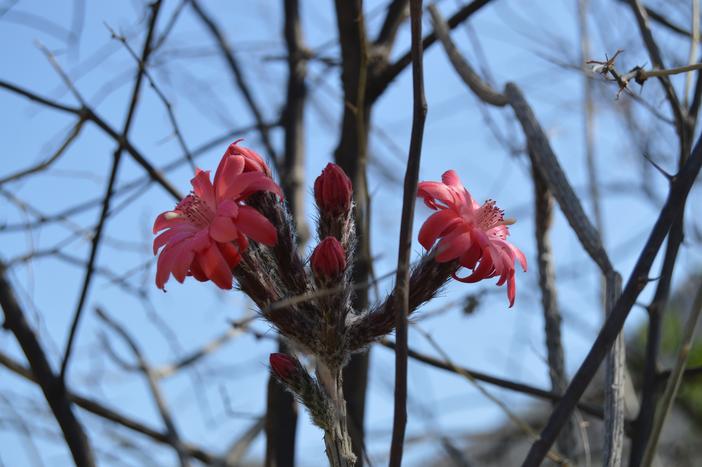Cardoncillo
(Peniocereus viperinus)
Cardoncillo (Peniocereus viperinus)
/
/

monitorzapotitlansalinas
CC BY 4.0
Image By:
monitorzapotitlansalinas
Recorded By:
Copyright:
CC BY 4.0
Copyright Notice:
Photo by: monitorzapotitlansalinas | License Type: CC BY 4.0 | License URL: https://creativecommons.org/licenses/by/4.0 | Uploader: Planckarte | Publisher: Wikipedia Commons












Estimated Native Range
Summary
Peniocereus viperinus, commonly known as Cardoncillo, is an evergreen or semi-deciduous succulent native to the arid and semi-arid regions of Central and Southwest Mexico, where it thrives in rocky outcrops and desert scrub environments. This plant can reach a height and spread of 12-20 feet (4-6 meters), presenting a candelabra-like form with slender, elongated stems. The stems are typically gray-green and may take on a more deciduous habit during periods of drought. Cardoncillo is notable for its nocturnal blooming habit, producing large, showy pink and red flowers in the summer that open at night and are pollinated by bats and moths.
Cardoncillo is valued for its sculptural form and striking flowers, making it a unique addition to xeriscapes, rock gardens, and desert-themed landscapes. It is also used as an ornamental in pots for patios and balconies. This succulent requires minimal maintenance and is drought-tolerant once established. It prefers well-draining soil and can tolerate a range of light conditions from part shade to full sun. While it is generally free of serious pests and diseases, overwatering can lead to root rot. It is important to note that Peniocereus viperinus should be protected from frost to prevent damage to the stems.CC BY-SA 4.0
Cardoncillo is valued for its sculptural form and striking flowers, making it a unique addition to xeriscapes, rock gardens, and desert-themed landscapes. It is also used as an ornamental in pots for patios and balconies. This succulent requires minimal maintenance and is drought-tolerant once established. It prefers well-draining soil and can tolerate a range of light conditions from part shade to full sun. While it is generally free of serious pests and diseases, overwatering can lead to root rot. It is important to note that Peniocereus viperinus should be protected from frost to prevent damage to the stems.CC BY-SA 4.0
Plant Description
- Plant Type: Succulent
- Height: 12-20 feet
- Width: 12-20 feet
- Growth Rate: Slow
- Flower Color: Pink, Red
- Flowering Season: Summer
- Leaf Retention: Evergreen
Growth Requirements
- Sun: Part Shade, Full Sun
- Water: Very Low, Low
- Drainage: Medium, Fast
Common Uses
Drought Tolerant, Low Maintenance, Showy Flowers
Natural Habitat
Arid and semi-arid regions, rocky outcrops, and desert scrub environments
Other Names
Common Names: Organito De Vibora, Cactus
Scientific Names: , Peniocereus viperinus, Cereus viperinus, Wilcoxia viperina, Wilcoxia papillosa, Peniocereus papillosus, Wilcoxia viperina var. tomentosa, Cullmannia viperina, Peniocereus tomentosus, Wilcoxia tomentosa,
GBIF Accepted Name: Peniocereus viperinus (F.A.C.Weber) Kreuz.